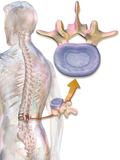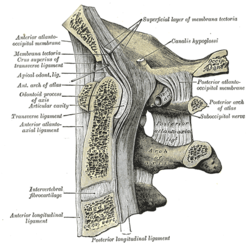Intervertebral disc
An intervertebral disc is a kind of padding between vertebrae in the vertebral column. They are shock absorbers in the spine, and are very important to the health of the spine. The disc is a fibrocartilaginous joint. It allows slight movement of the vertebrae, and acts as a ligament to hold the vertebrae together.
Discs have an outer fibrous ring, made up of both type I and type II collagen. Type I is concentrated towards the edge of the ring where it provides greater strength. The fibrous intervertebral disc contains the nucleus pulposus and this helps to distribute pressure evenly across the disc.
The nucleus pulposus contains loose fibers suspended in a mucoprotein gel. The nucleus of the disc acts as a shock absorber, absorbing impacts and keeping the two vertebrae separated. It is the remnant of the notochord.[1]
Intervertebral Disc Media
Micrograph showing a fragment of an intervertebral disc demonstrating degenerative fibrocartilage with loss of nuclei and nests of chondrocytes, as seen in degenerative disc disease. HPS stain.
References
- ↑ McCann, Matthew et al 2011. (2012). "Tracing notochord-derived cells using a Noto-cre mouse: implications for intervertebral disc development". Disease Models & Mechanisms. 5 (1): 73–82. doi:10.1242/dmm.008128. PMC 3255545. PMID 22028328.










